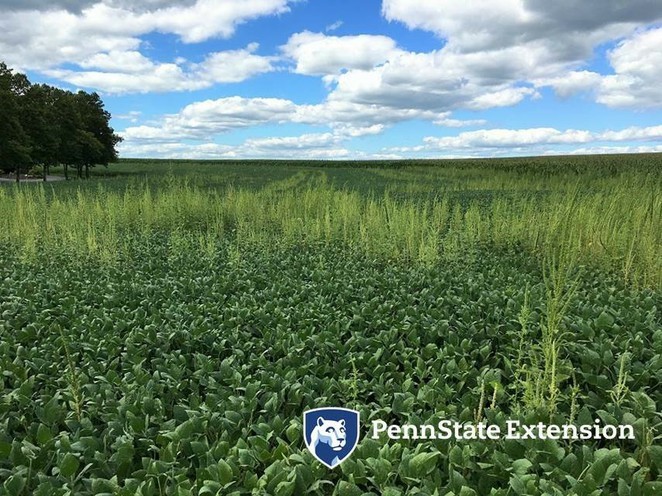
In previous Field Crop News articles, we have discussed the emergence of Palmer Amaranth and waterhemp as herbicide-resistant weeds gaining ground in Pennsylvania. In last week’s edition, Bill Curran mentioned fields in Southeastern Pennsylvania in which a heavy infestation of herbicide-resistant waterhemp could be seen growing in clear rows throughout the field.
How could such a weed growth pattern happen? In this case, a combine harvest in another field last season helped introduce and distribute the seeds. If the weeds are growing in defined tracks, such as in the photo above, that could indicate that the seeds have landed there from a combine that had the weed seeds riding on it from a previous harvest in an infested field.
Pigweed seeds are very small and can hide in tight areas of the combine. Since a single plant can contain upwards of 500,000 seeds, the introduction of even a few seeds can spark a serious and costly infestation.
Steps can be taken to help ensure that herbicide-resistant weed seeds, such as Palmer Amaranth and waterhemp, are not spread to new fields via combine:
- Harvest herbicide-resistant weed-infested fields last.
- Know whether the combine entering the field has recently been in a field containing herbicide-resistant weeds, such as waterhemp or Palmer Amaranth. If so, take the time needed to clean it or consider other available options.
- Herbicide-resistant pigweeds were introduced to Pennsylvania through transportation from other areas such as the Midwest and southeast where populations are more abundant. Therefore, when purchasing a used combine from out of state or from a county in Pennsylvania with known Palmer and waterhemp populations, take the necessary time to completely clean the combine before use.
- Utilize an air compressor to remove the bulk of the weed seeds from the combine.
- Check the rock trap, as weed seeds and debris may be caught here. Drop the rock trap and blow it out with the air compressor between fields.
- Open trapdoors to clean the grain auger and tailings processor with an air compressor.
- On a rainy day, consider a thorough 4- to 5-hour combine cleaning as a rainy day activity.
- Since weed seeds can also travel on tillage equipment, clean this equipment after infested fields as well.





